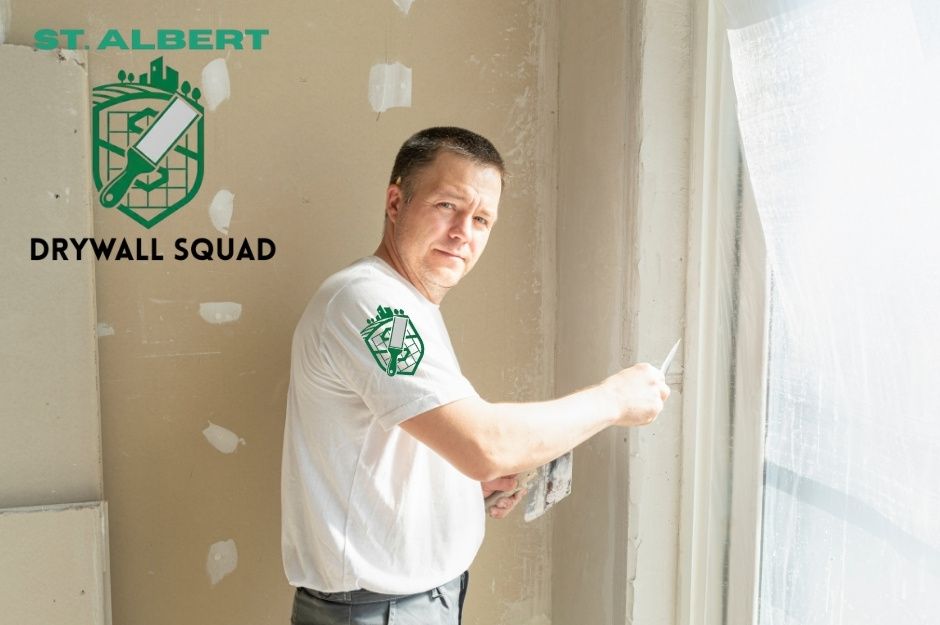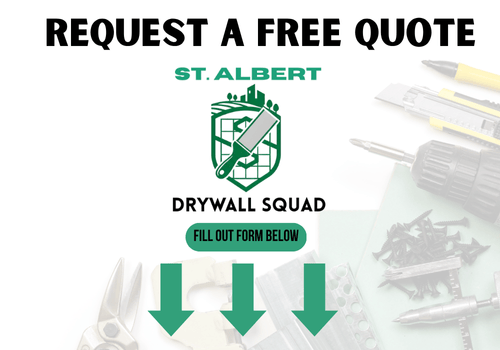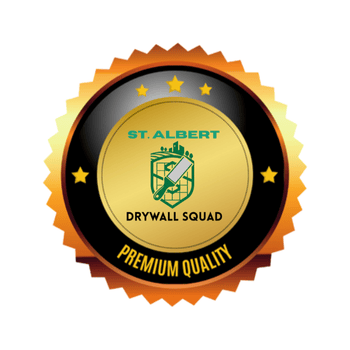Calmar Drywall Repair
Expert Drywall Repair Company in Calmar, Alberta

Finding reliable drywall repair contractors in Calmar, Alberta requires understanding the range of services available to address your home's wall and ceiling needs. Local drywall professionals at St. Albert Drywall Squad offer comprehensive solutions including patch repairs, crack fixing, hole restoration, water damage remediation, popcorn ceiling removal, complete installation, and professional finishing services.

St. Albert Drywall Squad (CP)

Serving this growing town of over 2,100 residents located 35 kilometres southwest of Edmonton, contractors must be prepared to handle both residential properties and commercial spaces in this Leduc County community.
Whether you're dealing with minor dings from furniture movement or extensive damage from plumbing and electrical work, skilled contractors provide both repair and installation expertise.. In Calmar's humid continental climate (Köppen Dfb), with temperature fluctuations ranging from winter lows of -17°C to summer highs of 23°C, drywall can experience unique stresses from seasonal expansion and contraction.
Your specific project requirements will determine which combination of repair, installation, and finishing services best suits your needs. Understanding the different service categories and what each contractor offers helps you make informed decisions about your drywall project investment.
Essential Drywall Repair Services in Calmar, Alberta
Calmar residents require comprehensive drywall solutions ranging from small patch jobs to extensive water damage restoration. Professional contractors handle everything from structural hole repairs and crack remediation to complete popcorn ceiling removal and custom texture matching. With Calmar's average annual precipitation of 515.7mm, including significant snowfall of 130.6cm, moisture-related drywall issues are particularly common in this central Alberta community.
Patch and Hole Repair
Your walls face daily wear from door handles, furniture impacts, and accidental damage. Professional contractors assess hole size to determine the best repair method.
Small holes under two inches typically receive mesh patches with compound application. Larger damages require cut-in patches using matching drywall pieces.
Common patch repair types:
- Nail holes and small punctures
- Door handle impacts
- Picture hanging damage
- Furniture collision marks
You need proper surface preparation before patching begins. Contractors clean debris, sand rough edges, and ensure solid backing for larger repairs.
The patching process involves multiple compound coats with sanding between applications. Final texture matching ensures seamless integration with existing wall surfaces.
Crack and Seam Restoration
Wall cracks develop from house settling, temperature changes, and structural movement. You must address these issues promptly to prevent further damage. Calmar's extreme temperature variations—with record lows reaching -49.4°C and record highs of 36.7°C—create significant thermal stress on homes, making crack repair particularly important for long-term structural integrity.
Contractors identify crack causes before beginning repairs. Settlement cracks require different treatment than seam separation or corner cracking.
Crack repair techniques include:
- Paper tape reinforcement
- Mesh tape application
- Structural crack assessment
- Joint compound smoothing
Seam restoration focuses on drywall panel joints that have separated or cracked over time. Professional wall repair involves re-taping and compound application across multiple coats.
Your contractor sands each layer smooth before applying the next coat. Proper seam repair prevents future cracking and maintains structural integrity.
Water Damage Assessment and Repair
Water damage requires immediate professional attention to prevent mold growth and structural deterioration. Contractors evaluate moisture extent before beginning drywall restoration. With Calmar receiving nearly 80mm of rainfall in June alone and experiencing spring snowmelt from over 21cm of March snowfall, water damage from roof leaks, foundation seepage, and plumbing issues poses significant risks to local homeowners.
You need complete moisture removal before any repair work begins. Professional assessment determines which sections require replacement versus repair.
Water damage evaluation covers:
- Moisture meter readings
- Insulation condition
- Framing integrity
- Mold presence detection
Damaged drywall sections receive complete removal and replacement. Contractors install new material after confirming dry conditions throughout the affected area.
Your repair includes primer application to seal new drywall before final paint application. Texture matching ensures repaired areas blend seamlessly with undamaged sections.
Popcorn Ceiling and Texture Removal
Popcorn ceiling removal requires specialized equipment and safety protocols due to potential asbestos content in older installations. Professional contractors test materials before beginning work. Given that Calmar was incorporated as a village in 1949 and became a town in 1954, many homes in the area may contain original popcorn ceilings from the 1950s-1980s construction boom, potentially containing asbestos materials.
You benefit from dust containment systems that protect your home during removal. Contractors use proper scrapers and spray techniques to minimize airborne particles.
Removal process includes:
- Asbestos testing procedures
- Plastic sheeting installation
- Controlled scraping methods
- Surface preparation for new texture
Ceiling texture removal extends beyond popcorn to include orange peel, knockdown, and other applied finishes. Your contractor matches existing textures in adjacent rooms.
Wall texturing services restore smooth finishes or apply new decorative patterns. Professional texture matching requires skill in compound application and timing for consistent results.
Professional Drywall Installation Solutions
Professional drywall installation contractors in Calmar provide comprehensive services for new construction and renovation projects. These services range from standard residential installations to specialized basement finishing and advanced soundproofing solutions. With Calmar's proximity to Edmonton International Airport and its role in the Leduc-Nisku Economic Development Association's Alberta's International Region, contractors serve both residential neighborhoods and growing commercial developments.
Residential Drywall Installation
Residential drywall installation involves mounting gypsum boards to wall and ceiling frames throughout your home. Professional contractors measure and cut sheets to fit around windows, doors, electrical outlets, and fixtures with precision.
The installation process begins with proper measurement and planning. Contractors assess your space and determine the appropriate drywall thickness for each area. Standard residential applications typically use 1/2-inch drywall for walls and 5/8-inch for ceilings.
Key Installation Steps:
- Frame inspection and preparation
- Drywall cutting and fitting
- Securing panels with screws or nails
- Joint taping and mudding
- Sanding and finishing
Proper installation around windows and doors requires careful attention to structural support. Contractors ensure joints align correctly and avoid placing seams at stress points. The finishing process includes multiple coats of joint compound to create smooth, paint-ready surfaces.
Quality residential drywall installation provides long-lasting durability and professional appearance for your home's interior walls and ceilings.
Drywall Installation for Basements and Garages
Basement and garage drywall installation presents unique challenges due to moisture concerns and temperature fluctuations. Contractors use moisture-resistant drywall and proper vapor barriers to prevent mold and deterioration. In Calmar's climate, where ground frost penetration can be significant during the 8+ months of potential snowfall, basement installations require special attention to moisture barriers and insulation coordination.
Basement-Specific Considerations:
- Moisture-resistant materials
- Insulation integration
- Foundation wall preparation
- Ceiling height adjustments
Garage installations require drywall that can withstand temperature changes and potential impact damage. Fire-rated drywall is often required between garages and living spaces for safety compliance. With winter temperatures in Calmar regularly dropping below -15°C and summer peaks reaching above 22°C, garage drywall must handle a temperature swing of over 35°C throughout the year.
Basement finishing projects frequently involve working around existing utilities, ductwork, and plumbing. Professional contractors plan installations to accommodate these elements while maintaining structural integrity.
Proper basement drywall installation transforms unfinished spaces into functional living areas while addressing moisture control and insulation needs.
Soundproofing and Insulation Integration
Advanced drywall installation incorporates soundproofing materials and insulation for enhanced comfort and energy efficiency. Contractors install insulation between studs before mounting drywall panels. Given Calmar's location along Highway 39 and Highway 795, homes near these transportation corridors particularly benefit from soundproofing installations to reduce road noise.
Soundproofing Options:
- Double-layer drywall systems
- Sound-dampening compounds
- Acoustic insulation materials
- Resilient channel installation
Insulation integration requires careful coordination between drywall and insulation contractors. Proper installation prevents thermal bridging and maintains consistent R-values throughout your walls.
Specialized installations may include green glue compounds between drywall layers or resilient channels that decouple walls from framing. These techniques significantly reduce sound transmission between rooms.
Professional contractors ensure insulation remains properly positioned during drywall installation to maintain energy efficiency and prevent settling issues.
Comprehensive Drywall Finishing and Surface Preparation
Professional drywall finishing transforms rough installations into smooth, paint-ready surfaces through systematic mudding, taping, and sanding processes. Proper texture matching ensures seamless integration with existing walls.
Mudding and Taping Processes
Mudding and taping form the foundation of professional drywall finishing services. Contractors apply joint compound along seams and cover them with mesh or paper tape to create strong, invisible joints.
The process begins with embedding tape into a thin layer of compound. Professional contractors use taping knives ranging from 4 to 12 inches wide for different stages of application.
Multiple coat system:
- First coat: Embeds tape and fills major gaps
- Second coat: Widens coverage and smooths ridges
- Third coat: Creates final smooth finish
Each layer must dry completely before the next application. Temperature and humidity affect drying times significantly. Contractors feather edges outward to blend transitions seamlessly. In Calmar's variable humidity conditions—with precipitation days averaging 105.4 annually—contractors must carefully monitor indoor conditions to ensure proper compound drying between coats, particularly during the humid summer months when rainfall peaks at 109.6mm in July.
Corner beads require special attention during mudding. Metal or plastic corner beads protect outside corners while providing straight, durable edges that resist damage.
Sanding and Surface Smoothing
Sanding removes imperfections and creates uniform surfaces ready for painting or texturing. Professional contractors use progressively finer grits to achieve smooth results without damaging the paper face of drywall.
Sanding progression:
- Coarse grit (80-100): Removes major ridges and bumps
- Medium grit (120-150): Smooths moderate imperfections
- Fine grit (220): Final surface preparation
Power sanders speed the process but require skill to avoid gouging. Hand sanding provides better control around delicate areas and corners.
Dust control is essential during sanding operations. Professional contractors use vacuum sanders or plastic sheeting to contain debris and protect your furniture.
Proper lighting reveals surface imperfections invisible under normal conditions. Contractors use work lights positioned at sharp angles to identify areas needing additional attention.
Texture and Finish Matching
Texture matching requires skilled application techniques to blend new work with existing surfaces. Contractors analyze existing patterns before selecting appropriate tools and materials.
Common texture types:
- Orange peel
- Knockdown
- Smooth finish
- Stipple patterns
Spray textures provide consistent coverage for large areas. Hand-applied textures using brushes, rollers, or trowels work better for small repair sections.
Color variations in joint compound can show through paint. Prime all repaired areas before applying final coats to ensure uniform appearance.
Professional contractors test texture patterns on sample boards first. This allows adjustment of spray pressure, compound consistency, and application technique before working on visible surfaces.
Matching existing textures around popcorn ceiling removal areas requires particular expertise. The transition between textured and smooth surfaces must appear intentional rather than patched.
Additional Services Offered by Drywall Repair Contractors
Most drywall contractors in Calmar expand their expertise beyond basic wall repairs to include ceiling work, painting services, and broader renovation projects. These complementary services help you complete your interior projects with a single trusted contractor. Serving a community positioned within the Edmonton Metropolitan Region and connected to Leduc County's growing economy, local contractors often diversify their services to meet the needs of both residential and light commercial clients.
Ceiling Repair and Texturing
Ceiling repairs often require specialized techniques that experienced drywall contractors master alongside wall work. Water damage from roof leaks creates common ceiling problems that need immediate attention to prevent structural issues.
T-bar ceiling systems present unique challenges in commercial spaces. Contractors familiar with these suspended ceiling grids can repair damaged tiles and adjust framework alignment.
Texture matching becomes critical when repairing ceiling sections. Popular ceiling textures include:
- Knockdown texture - Creates subtle patterns
- Orange peel - Light, consistent bumps
- Smooth finish - Clean, modern appearance
Popcorn ceiling removal requires proper safety equipment and disposal methods. Many contractors offer this service due to potential asbestos concerns in older homes.
Painting and Priming
Professional painting services naturally complement drywall repairs since fresh repairs require primer and paint to match existing surfaces. Most contractors use high-quality primers that seal new drywall and prevent color bleeding.
Color matching expertise helps contractors blend repairs seamlessly with existing paint. They often maintain relationships with paint suppliers in Calgary for consistent material sourcing. Calmar contractors also coordinate with suppliers in the Edmonton area, located just 35 kilometres to the northeast, ensuring quick access to materials and specialty products.
Interior painting projects frequently follow drywall installations. Contractors can handle both phases, ensuring proper surface preparation and finish quality.
Some contractors offer exterior painting services alongside interior work. This expanded service range provides convenience for complete home renovations.
Related Renovations: Flooring, Decks, and More
Many drywall contractors develop skills in complementary trades to offer comprehensive renovation services. Flooring installation often follows drywall completion, making combined services efficient for homeowners.
Basic plumbing knowledge helps contractors work around existing fixtures during wall installations. They coordinate with licensed plumbers when major modifications are needed.
Deck construction and repairs represent common expansion services for contractors comfortable with carpentry work. These outdoor projects often complement interior renovations. In Calmar's climate, with over 8 months of potential freezing temperatures and precipitation throughout the year, deck installations require expertise in weather-resistant materials and proper drainage to handle the town's 515.7mm annual precipitation.
Trim installation and crown molding work require precision cutting and fitting skills that transfer well from drywall finishing techniques. Named after Kalmar, Sweden—the hometown of Calmar's first postmaster C. J. Blomquist in 1900—this historic town's blend of heritage homes and modern construction provides contractors with diverse renovation opportunities across different architectural styles and building ages.